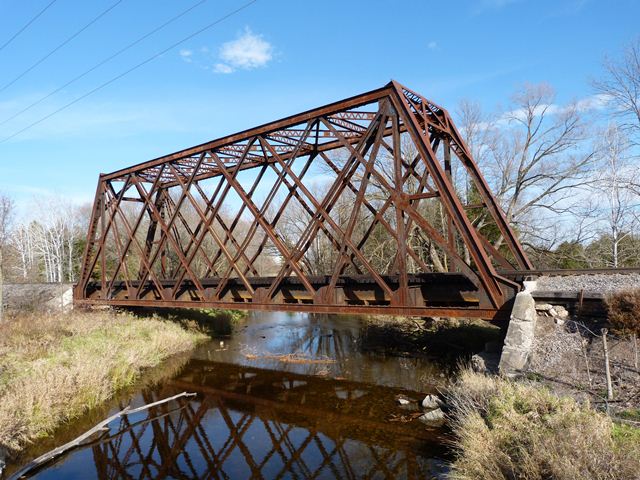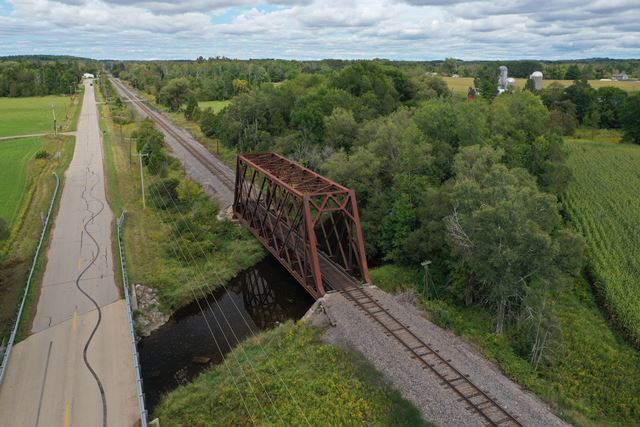We Recommend:
Bach Steel - Experts at historic truss bridge restoration.
BridgeHunter.com Phase 1 is released to the public! - Visit Now
Daggett Railroad Bridge

Primary Photographer(s): Nathan Holth
Bridge Documented: October 1, 2012
Daggett: Menominee County, Michigan: United States
1917 By Builder/Contractor: Wisconsin Bridge and Iron Company of Milwaukee, Wisconsin
Not Available or Not Applicable
120.0 Feet (36.6 Meters)
120.0 Feet (36.6 Meters)
12 Feet (3.66 Meters)
1 Main Span(s)
Not Applicable

View Information About HSR Ratings
Bridge Documentation
View A Historical Article Suggesting Why Chicago Northwestern Liked Lattice Truss Bridges

This is one of three similar railroad through truss bridges on the Chicago Northwestern Railway Line in Michigan, which is today owned by Canadian National and remains active. Lattice truss bridges are range from uncommon to rare nationwide. However, Chicago Northwestern was a strong supporter of the lattice truss for railroad bridges, so its railroad lines have a larger than average number of these distinctive and visually pleasing truss bridges. In 1890, Chicago Northwestern engineer William H. Finley commented that he felt that the lattice through truss was the best type of truss bridge for spans from 100-130 feet, and he felt is was superior to other types of bridges including pony truss bridges. One of the major reasons was that the bridges stood up well to train derailments. In one example, multiple truss members were severed from the bridge during a derailment and the remainder of the bridge was able to continue standing with no deformation, allowing the bridge to be repaired rather than replaced. Nearly 20 years later, in 1917, it appears that the company continued to believe that the lattice truss was a reliable choice. Modern engineers tend to condemn truss bridges as "fracture critical" suggesting that failure of a single member will cause the entire bridge to collapse. The reality is that this is not always the case, and the lattice truss in particular appears to have good redundancy. Its quadruple intersection truss web is in effect like more than one regular Warren truss superimposed on top of each other.
This bridge was built in 1917 and as such is a later example of a Chicago Northwestern Railway lattice truss. Typical of the later examples, the bridge has heavy a-frame portal bracing, as opposed to the somewhat ornate lattice portal bracing the railroad used on its earlier examples from in the late 1880s.
According to Historic American Engineering Record, The Chicago and Northwestern Railroad extended its line from Menominee to Powers in 1877. passing through Stephenson, making this at least the second bridge at this location. Further evidence of this can be observed by seeing that the abutments for this bridge are stone, with concrete on top. The stone is likely from the previous bridge, and the concrete was added to support the 1917 bridge. Remains of wooden piles can be found under the bridge as well, these are likely either from a previous bridge, or from falsework used to erect the 1917 bridge. The truss bridge appears to retain excellent historic integrity with no alterations. The only thing missing is the builder plaques on the bridge, which appear to have either been stolen or fallen off.
Above: Aerial view of bridge, September 10, 2020. Click for enlargement. Photo Credit: Doug Heim, Angelcopter, LLC
![]()
Photo Galleries and Videos: Daggett Railroad Bridge
Bridge Photo-Documentation
Original / Full Size PhotosA collection of overview and detail photos. This gallery offers photos in the highest available resolution and file size in a touch-friendly popup viewer.
Alternatively, Browse Without Using Viewer
![]()
Bridge Photo-Documentation
Mobile Optimized PhotosA collection of overview and detail photos. This gallery features data-friendly, fast-loading photos in a touch-friendly popup viewer.
Alternatively, Browse Without Using Viewer
![]()
Drone Footage, Courtesy Doug Heim, Angelcopter, LLC
Full Motion VideoNote: The downloadable high quality version of this video (available on the video page) is well worth the download since it offers excellent 1080 HD detail and is vastly more impressive than the compressed streaming video. Streaming video of the bridge. Also includes a higher quality downloadable video for greater clarity or offline viewing.
![]()
Maps and Links: Daggett Railroad Bridge
Coordinates (Latitude, Longitude):
Search For Additional Bridge Listings:
Bridgehunter.com: View listed bridges within 0.5 miles (0.8 kilometers) of this bridge.
Bridgehunter.com: View listed bridges within 10 miles (16 kilometers) of this bridge.
Additional Maps:
Google Streetview (If Available)
GeoHack (Additional Links and Coordinates)
Apple Maps (Via DuckDuckGo Search)
Apple Maps (Apple devices only)
Android: Open Location In Your Map or GPS App
Flickr Gallery (Find Nearby Photos)
Wikimedia Commons (Find Nearby Photos)
Directions Via Sygic For Android
Directions Via Sygic For iOS and Android Dolphin Browser
USGS National Map (United States Only)
Historical USGS Topo Maps (United States Only)
Historic Aerials (United States Only)
CalTopo Maps (United States Only)



